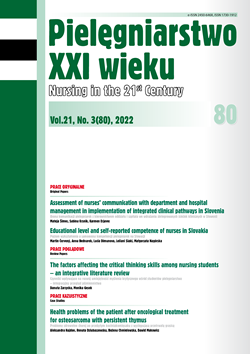Assessment of nurses’ communication with department and hospital management in implementation of integrated clinical pathways in Slovenia
DOI:
https://doi.org/10.2478/pielxxiw-2022-0022Keywords:
nurse, communication, integrated clinical pathway, management hospitalAbstract
ASSESSMENT OF NURSES’ COMMUNICATION WITH DEPARTMENT AND HOSPITAL MANAGEMENT IN IMPLEMENTATION OF INTEGRATED CLINICAL PATHWAYS IN SLOVENIA
Introduction. An important factor in the implementation of innovations such as integrative clinical care pathways (ICPs) is supportive communication from department and hospital management. ICPs have been introduced into the clinical environment as a tool to improve the quality, safety and effi ciency of health services.
Aim. The study aimed to assess communication of nurses working in three ICPs and department heads and hospital managers in a typical Slovenian hospital and to identify the main reasons for this communication using a mixed methods approach.
Material and methods. The cross-sectional study used a mixed descriptive quantitative method with a survey and a qualitative method with a focus group interviews of nurses working in ICPs for chronic kidney disease, stroke and total hip arthroplastyin a typical Slovenian hospital.
Result and conclusion. The results showed that communication plays an important role in the implementation of ICPs and thatnurses communicate worse with hospital managers than with department heads, regardless of age, gender, education and ICPs. Themain reasons for poor communication in the implementation of ICPs are communication-related (weak exchange of information,lack of appropriate communication channels, one-sided and authoritative communication on the part of hospital managers) and organisational (lack of staff , disorganisation of nursing staff ).
References
1. Cook S, Scott M. Framework for the implementation of integrated care pathways: Part 2. Journal of Integrated Care Pathways. 2005; 9(1): 39-45.
2. Hogan C, Barry M, Burke M, et al. Healthcare professionals’ experiences of the implementation of integrated care pathways. International journal of health care quality assurance. 2011; 24(5): 334-347.
3. Busetto L, Luijkx K, Calciolari S, et al. Barriers and Facilitators to Workforce Changes in Integrated Care. International journal of integrated care. 2018; 18(2): 17.
4. Vanhaecht K, De Witte K, Sermeus W. The impact of clinical pathways on the organisation of care processes. PhD dissertation, Belgium: KU Leuven; 2007.
5. Sleeman KE, Koff man J, Bristowe K, et al. It doesn’t do the care for you: a qualitative study of health care professionals’ perceptions of the benefi ts and harms of integrated care pathways for end of life care. BMJ Open. 2015; 5(9): 1-7.
6. Seys D, Panella M, VanZelm R, et al. Care pathways are complex interventions in complex systems: New European Pathway Association framework. International Journal of Care Coordination. 2019; 22(1): 5-9.
7. Schrijvers G, van Hoorn A, Huiskes N. The care pathway: Concepts and theories: An introduction. International journal of integrated care. 2012; 12(I).
8. de Stampa M, Vedel I, Bergman H, et al. Fostering participation of general practitioners in integrated health services networks: incentives, barriers, and guidelines. BMC Health Services Research. 2009; 9: 48.
9. Mc Hugh S, O’Mullane M, Perry IJ, et al. Barriers to, and facilitators in, introducing integrated diabetes care in Ireland. BMJ Open. 2013; 3: e003217.
10. Carmont S-A, Mitchell G, Senior H, et al. Systematic review of the eff ectiveness, barriers and facilitators to general practitioner engagement with specialist secondary services in integrated palliative care. BMJ Support Palliative Care. 2018; 8: 385-399.
11. Averlant L, Calafi ore M, Puisieux F, et al. Barriers and Facilitators in the Uptake of Integrated Care Pathways for Older Patients by Healthcare Professionals: A Qualitative Analysis of the French National “Health Pathway of Seniors for Preserved Autonomy” Pilot Program. International journal of integrated care. 2021; 21(2): 7.
12. Deneckere S, Euwema M, Lodewijckx C, et al. The European quality of care pathways (EQCP) study on the impact of care pathways on interprofessional teamwork in an acute hospital setting: study protocol: for a cluster randomized controlled trial and evaluation of implementation processes. Implementation Science. 2012; 7: 47.
13. Wilson, Sonja B. Nurses’ Perspective of Leadership Communication and Nursing Churn in an Upstate South Carolina Hospital. Dissertations: Northcentral University, 2019.
14. Aquino MRJ, Mullis R, Moore C, et al. “It’s Diffi cult, There’s No Formula”: Qualitative Study of Stroke Related Communication between Primary and Secondary Healthcare Professionals. International journal of integrated care. 2020; 20(4): 1-10.
15. Feigin VL, Norrving B, Mensah GA. Global Burden of Stroke. Circulation Research. 2017; 120(3): 439-448.
16. Rubin S, Orieux A, Clouzeau B, et al. The Incidence of Chronic Kidney Disease Three Years after Non-Severe Acute Kidney Injury in Critically Ill Patients: A Single-Center Cohort Study. Journal of Clinical Medicine. 2019; 8(12): 2215.
17. Lankhorst NE, Damen J, Oei EH, et al. Incidence, prevalence, natural course and prognosis of patellofemoral osteoarthritis: the Cohort Hip and Cohort Knee study. Osteoarthritis and Cartilage. 2017; 25(5): 647-653.
18. Cramm JM, Nieboer AP. Professionals’ views on interprofessional stroke team functioning. International journal of integrated care. 2011; 11: e081.
19. Hustoft M, Hetlevik Ø, Aßmus J, et al. Communication and Relational Ties in Inter- Professional Teams in Norwegian Specialized Health Care: A Multicentre Study of Relational Coordination. International journal of integrated care. 2018; 18(2): 9.
20. Karatuna I, Jönsson S, Muhonen T. Workplace bullying in the nursing profession: A cross-cultural scoping review. International journal of nursing studies. 2020; 111: 103628-103628.
Downloads
Published
Issue
Section
License
Copyright (c) 2022 Authors

This work is licensed under a Creative Commons Attribution 4.0 International License.




